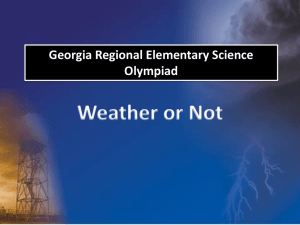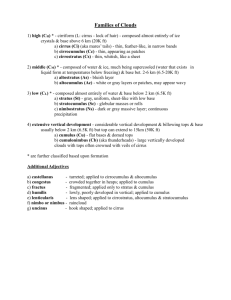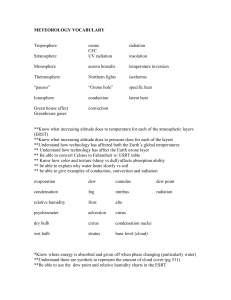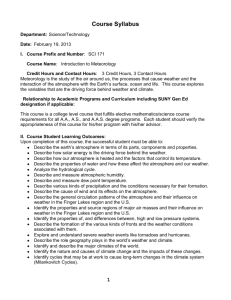Chapters 1-3
advertisement
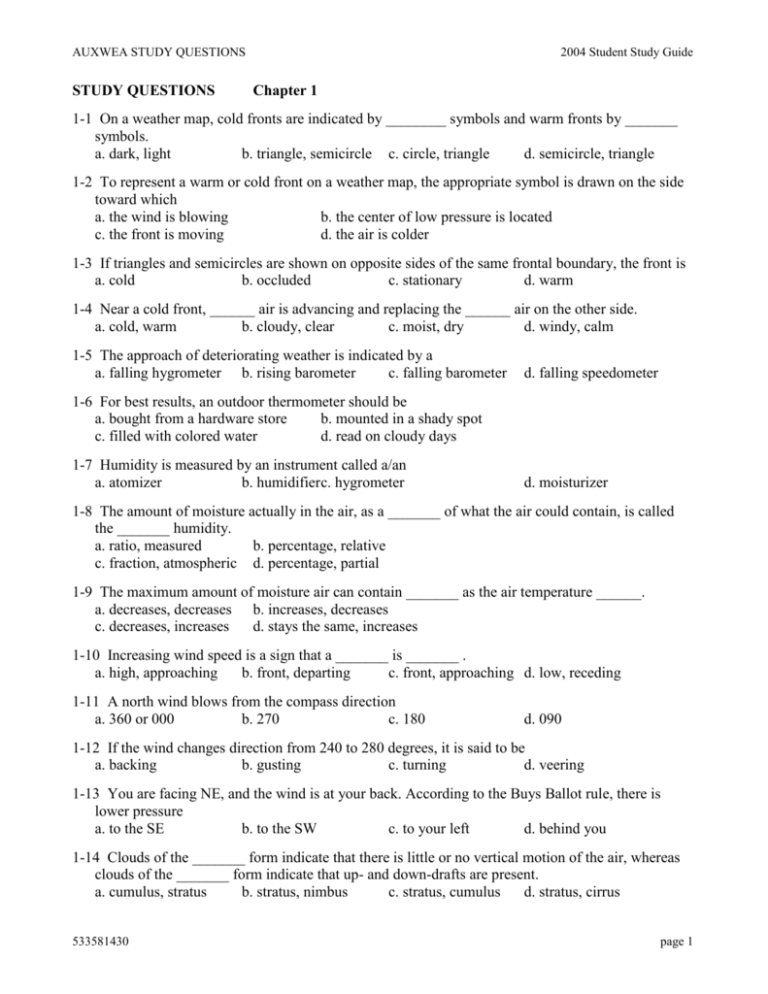
AUXWEA STUDY QUESTIONS STUDY QUESTIONS 2004 Student Study Guide Chapter 1 1-1 On a weather map, cold fronts are indicated by ________ symbols and warm fronts by _______ symbols. a. dark, light b. triangle, semicircle c. circle, triangle d. semicircle, triangle 1-2 To represent a warm or cold front on a weather map, the appropriate symbol is drawn on the side toward which a. the wind is blowing b. the center of low pressure is located c. the front is moving d. the air is colder 1-3 If triangles and semicircles are shown on opposite sides of the same frontal boundary, the front is a. cold b. occluded c. stationary d. warm 1-4 Near a cold front, ______ air is advancing and replacing the ______ air on the other side. a. cold, warm b. cloudy, clear c. moist, dry d. windy, calm 1-5 The approach of deteriorating weather is indicated by a a. falling hygrometer b. rising barometer c. falling barometer d. falling speedometer 1-6 For best results, an outdoor thermometer should be a. bought from a hardware store b. mounted in a shady spot c. filled with colored water d. read on cloudy days 1-7 Humidity is measured by an instrument called a/an a. atomizer b. humidifier c. hygrometer d. moisturizer 1-8 The amount of moisture actually in the air, as a _______ of what the air could contain, is called the _______ humidity. a. ratio, measured b. percentage, relative c. fraction, atmospheric d. percentage, partial 1-9 The maximum amount of moisture air can contain _______ as the air temperature ______. a. decreases, decreases b. increases, decreases c. decreases, increases d. stays the same, increases 1-10 Increasing wind speed is a sign that a _______ is _______ . a. high, approaching b. front, departing c. front, approaching d. low, receding 1-11 A north wind blows from the compass direction a. 360 or 000 b. 270 c. 180 d. 090 1-12 If the wind changes direction from 240 to 280 degrees, it is said to be a. backing b. gusting c. turning d. veering 1-13 You are facing NE, and the wind is at your back. According to the Buys Ballot rule, there is lower pressure a. to the SE b. to the SW c. to your left d. behind you 1-14 Clouds of the _______ form indicate that there is little or no vertical motion of the air, whereas clouds of the _______ form indicate that up- and down-drafts are present. a. cumulus, stratus b. stratus, nimbus c. stratus, cumulus d. stratus, cirrus 533581430 page 1 AUXWEA STUDY QUESTIONS 2004 Student Study Guide 1-15 Clouds are divided into ______ , ______ , and ______ families according to the heights of their bases. a. high, middle, low b. low, high, extensive vertical development c. stratus, cumulus, cirrus d. high, low, surface 1-16 Clouds of extensive vertical development include a. stratocumulus and cumulonimbus b. towering cumulus and nimbostratus c. towering cumulus and cumulonimbus d. nimbostratus and cumulonimbus 1-17 The prefix “nimbo–” or suffix “–nimbus” is attached to a cloud form when it is a. dissipating b. lowering c. raining d. thickening 1-18 An approaching cold front would be indicated by ______ , ______, and ______ clouds. a. cirrus, cirrocumulus, altocumulus b. cirrus, cirrostratus, altostratus c. cirrus, cirrocumulus, nimbostratus d. altocumulus, cirrocumulus, cirrus 1-19 An approaching warm front would be indicated by ______ , ______, and ______ clouds. a. cirrus, cirrocumulus, altocumulus b. cirrus, cirrostratus, altostratus c. cirrus, cirrocumulus, nimbostratus d. altocumulus, cirrocumulus, cirrus 1-20 With your arm stretched out and your bottom finger on the horizon, you observe that the cloud base loses detail at a point on a sight line that is half your hand high. You estimate the height of the cloud base to be ______ feet. a. 2,500 b. 5,000 c. 10,000 d. 25,000 STUDY QUESTIONS Chapter 2 2-1 The most important cause of weather is a. gravity b. latent heat of condensation c. uneven solar heating d. regions of high and low pressure 2-2 Winds generally blow a. during daytime c. toward areas of high pressure b. toward areas of low pressure d. toward areas of low density 2-3 Half the water vapor in the atmosphere is found a. above the dew point b. below the troposphere c. below the tropopause d. below 6,500 feet above sea level 2-4 The proportions of dry constituents in the atmosphere a. are always the same b. decrease as moisture increases c. vary with density d. vary with temperature 2-5 Density is the ______ of a substance divided by its ______. a. pressure, area b. weight, volume c. weight, area d. pressure, volume 2-6 A temperature of 77 °F is equal to ___ °C. a. 11 b. 25 c. 61 d. 75 2-7 A temperature of 35 °C is equal to ___ °F. a. 31 b. 51 c. 95 d. 121 533581430 page 2 AUXWEA STUDY QUESTIONS 2004 Student Study Guide 2-8 Which of the following statements are true? a. A quart of air at 70 °F contains less heat than a quart of water at 70 °F. b. A pint of air at 70 °F contains less heat than a quart of air at 70 °F. c. A quart of air at 50 °F contains less heat than a quart of air at 70 °F. d. All of the above. 2-9 Pressure is proportional to the product of a. absolute temperature and density b. temperature and absolute density c. temperature and absolute humidity d. absolute temperature and humidity 2-10 Which is heavier, a pound of air or a pound of iron? a. The air b. The iron c. Neither, they have the same density d. Neither, but the iron is more dense 2-11 An Auxiliarist weighing 150 pounds stands on a scale with an area of half a square foot. A weight of 300 pounds sits on a piece of plywood with an area of one square foot. a. The pressure on the scale is less than the pressure on the plywood. b. The pressure on the scale is the same as the pressure on the plywood. c. The pressure on the scale is more than the pressure on the plywood. d. There is more weight on the scale. 2-12 When air is free to expand, its temperature may be changed by a. changing its volume b. adding heat energy c. removing heat energy d. all of the above 2-13 If the volume of some air increases by ten percent, but the temperature of the air remains constant, the air pressure will a. decrease by ten percent b. increase by ten percent c. not change d. be proportional to the volume 2-14 Standard atmospheric temperature and pressure at sea level are a. 59 °F and 29.92 inches of mercury b. 15 °C and 29.92 millibars c. 15°C and 1013.2 millibars d. either a. or c. 2-15 Standard values of atmospheric temperature, pressure, and density a. are world wide averages b. are different at different altitudes c. both of the above d. none of the above 2-16 Almost all of the earth’s weather occurs a. in the tropopause b. in the troposphere c. below an altitude of 6,500 feet d. above the tropopause 2-17 The height of the tropopause is generally between ______ feet above sea level a. 6,500 and 30,000 b. 25,000 and 30,000 c. 6,500 and 65,000 d. 25,000 and 65,000 2-18 A hot air balloon tends to rise because a. the air in the balloon is less dense than the surrounding air outside the balloon b. the pressure in the balloon is greater than the pressure outside the balloon c. the air in the balloon is warmer than the air outside the balloon d. the air in the balloon contains more heat energy than the air outside the balloon 533581430 page 3 AUXWEA STUDY QUESTIONS 2004 Student Study Guide 2-19 The amount of water vapor in the atmosphere a. may be as much as 4 percent b. is usually lower near the poles than in the tropics c. is usually greater over coastal areas and oceans than over mid-continental areas d. all of the above 2-20 Air is saturated when it contains a. four percent water vapor b. as much water vapor as it can hold at a given temperature c. any water vapor below the dew point d. none of the above 2-21 The amount of water vapor in the air, expressed as a percentage of the amount that would saturate the air, is called the a. density b. dew point c. relative humidity d. absolute humidity 2-22 Moist air in the atmosphere can be saturated by a. removal of heat b. addition of moisture c. cooling due to expansion d. all of the above 2-23 If the temperature of the air falls below its dew point, then a. condensation or deposition will occur until the dew point equals the lower temperature b. moisture will evaporate c. the saturation will be reduced d. none of the above 2-24 The air in the atmosphere absorbs heat when water changes state in which of the follow-ing processes? a. Condensation and evaporation b. Deposition and sublimation c. Freezing and condensation d. Melting and freezing 2-25 The best measurement for predicting the likelihood of rain is the a. air temperature b. dew point c. relative humidity d. absolute humidity STUDY QUESTIONS Chapter 3 3-1 A convective current transports _____ by means of ________. a. temperature, heat exchange b. heat, conduction c. heat, material exchange d. radiation, transfer 3-2 Warm, dry air rising into colder air transports _________ heat. a. latent b. molecular c. sensible d. sensitive 3-3 Rising moist air transports both sensible and _______ heat. a. advective b. infrared c. latent d. vaporous 3-4 A wind blowing warm air from the south toward colder air to the north is transporting heat by means of a. advection b. conduction c. convection d. radiation 3-5 When sunshine strikes the earth’s surface, a layer of soil below the surface is warmed by a. advection b. conduction c. convection d. radiation 533581430 page 4 AUXWEA STUDY QUESTIONS 2004 Student Study Guide 3-6 At night, the temperature of a soil layer will decrease faster than the temperature of an ocean water layer because a. there is no solar radiation at night b. the surfaces emit infrared to the atmosphere c. the soil heat capacity is greater d. the soil heat capacity is lower 3-7 Warm land and water surfaces radiate heat to the atmosphere at ______ wavelengths. a. infrared b. radio c. ultraviolet d. visible 3-8 Heat from the sun is ultimately returned to space by mainly means of a. reflected ultraviolet radiation b. infrared radiation c. advection and convection d. sublimation 3-9 Convection in the atmosphere occurs when ______ warms the ______ . a. ultraviolet, ozone layer b. latent heat, troposphere c. solar radiation, surface d. sensible heat, tropopause 3-10 The standard atmosphere temperature at an altitude of ten thousand feet is a. – 16 °C b. – 5 °C c. +39 °C d. +39 °F 3-11 The three factors which cause deviations from the global average heat balance are: a. advection, diurnal, and seasonal b. diurnal, latitude, and longitude c. latitude, seasonal, and diurnal d. latitude, longitude, and convection 3-12 Diurnal variation means that the earth ______ heat during the day and ______ heat during the night. a. absorbs, advects b. gains, loses c. absorbs, emits d. gains, reflects 3-13 The earth’s surface temperature is generally coldest a. just after sundown b. at midnight c. just before dawn 3-14 The earth emits infrared radiation a. all the time b. only at night d. just after dawn c. only during the day d. only from the tropics 3-15 Atmospheric convection not associated with frontal activity is generally strongest a. just after dawn b. in the morning c. in the afternoon d. just before sunset 3-16 Seasonal variation of solar heating is caused by the earth’s ______ and ______ . a. atmosphere, axial tilt b. axial tilt, orbit around the sun c. orbit, latitude d. axial tilt, latitude 3-17 Latitude variation of solar heating is a result of differences in ______ and ______ . a. the earth’s axial tilt, the earth’s orbit b. axial tilt, sun angle c. sun angle, distance rays must travel through the atmosphere d. the earth’s orbit, distance rays must travel through the atmosphere 3-18 Blustery winter weather is a result of a. seasonal variation causing strong advection b. large latitude variation of solar heating c. distance the sun’s rays must travel through the atmosphere d. low sun angle 533581430 page 5 AUXWEA STUDY QUESTIONS 2004 Student Study Guide 3-19 Atmospheric water vapor will condense a. as soon as the air cools to its dew point c. below 0 °C b. between the dew point and 0 °C d. below 0 °F 3-20 Ice crystals may form when moist air a. cools to below the freezing point c. becomes saturated b. cools to its dew point d. encounters clouds 3-21 ______ is especially dangerous if encountered by vessels or aircraft. a. snow b. sleet c. ice pellets d. freezing rain 533581430 page 6

